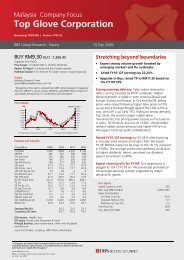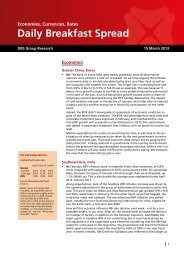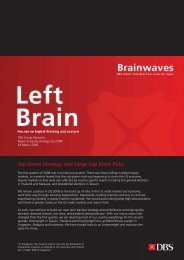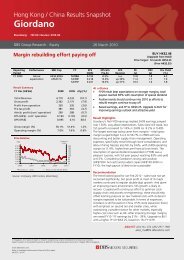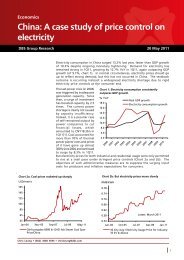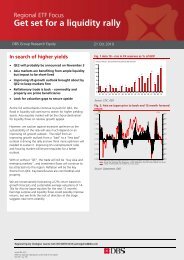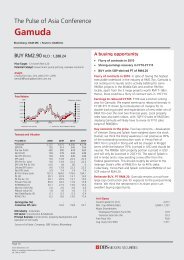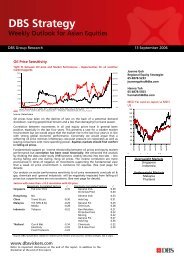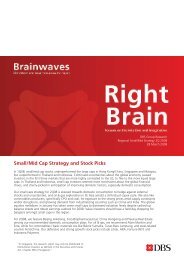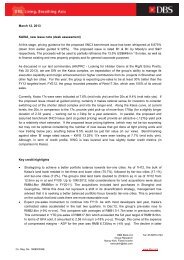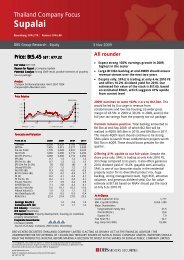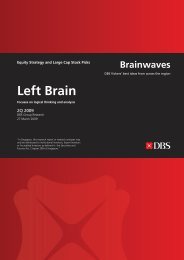Economics Markets Strategy - the DBS Vickers Securities Equities ...
Economics Markets Strategy - the DBS Vickers Securities Equities ...
Economics Markets Strategy - the DBS Vickers Securities Equities ...
Create successful ePaper yourself
Turn your PDF publications into a flip-book with our unique Google optimized e-Paper software.
Currencies<br />
<strong>Economics</strong> – <strong>Markets</strong> – <strong>Strategy</strong><br />
Indonesian rupiah – moving above 8700-9500 range<br />
USD/IDR<br />
forecast, eop<br />
Latest Prev<br />
Close 9310 9160<br />
2Q08 9300 9300<br />
3Q08 9500 9000<br />
4Q08 9600 8700<br />
1Q09 9700 9000<br />
2Q09 9800 9000<br />
3Q09 9500 8980<br />
4Q09 9300 8980<br />
BI benchmark rate<br />
forecast, eop<br />
Latest Prev<br />
Close 8.50 8.00<br />
2Q08 8.75 8.00<br />
3Q08 9.25 8.00<br />
4Q08 9.25 8.00<br />
1Q09 9.25 8.00<br />
2Q09 9.25 8.00<br />
3Q09 9.25 8.00<br />
4Q09 9.25 8.00<br />
Latest close on Jun 11<br />
Prev close on Mar 12<br />
Since 2006, Bank Indonesia (BI) has successfully kept USD/IDR stable in a broad<br />
range between 8700 and 9500. We think that this is about to change.<br />
Despite oil prices surging to USD98/barrel from USD61 in 2007, depreciation<br />
pressures on <strong>the</strong> rupiah were offset by a number of factors. To a great extent,<br />
<strong>the</strong> central bank’s ability to maintain a stable rupiah could be attributed to <strong>the</strong><br />
reflationary environment that followed <strong>the</strong> aggressive fuel price hikes in Oct<br />
2005. As inflation eased from a high of 18.4% YoY in Nov 2005 to a stable range<br />
between 5.3% and 7.0% from Oct 2006 to Dec 2007, <strong>the</strong> central bank lowered<br />
interest rates from 12.75% to 8.00%.<br />
During <strong>the</strong>se two years, <strong>the</strong> Jakarta stock market delivered annual gains of more<br />
than 50%, correctly betting on economic growth to return to pre-crisis levels<br />
above 6%. Meanwhile, foreign reserves started to accummulate at a faster rate<br />
from 2006, and overtook private sector external debt in 2007. The merchandise<br />
trade surplus was strong at almost USD40bn in 2006 and 2007, well above <strong>the</strong><br />
average USD26bn posted in <strong>the</strong> previous eight years. This helped to assuage<br />
concerns about Indonesia’s net oil importer status. Of course, it did not hurt<br />
that <strong>the</strong> USD was weak internationally from <strong>the</strong> aggressive rate cuts during <strong>the</strong><br />
US mortgage/credit crisis that started in Jul 2007.<br />
Unfortunately, this did not last. The positive factors responsible for rupiah stability<br />
in <strong>the</strong> past couple of years started to deteriorate in 2008. As at Jun 2, <strong>the</strong> stock<br />
market has fallen by 12% since <strong>the</strong> start of <strong>the</strong> year, in line with waning consumer<br />
confidence. Oil prices have become a problem as <strong>the</strong>y extended <strong>the</strong>ir ascent to<br />
as high as USD133/barrel on May 21. Apart from lifting inflation to double-digit<br />
levels by May08, high oil prices started to strain fiscal finances as well as to<br />
narrow <strong>the</strong> trade surplus. BI brought forward its policy meeting by two-days to<br />
May 6 and lifted <strong>the</strong> reference rate by 25bps hike to 8.25%. To alleviate <strong>the</strong><br />
pressures on fiscal finances from record high oil prices, <strong>the</strong> government raised<br />
fuel prices by 28.7% on May 24, leaving <strong>the</strong> door open for more hikes and fuel<br />
subsidy cuts should <strong>the</strong> oil prices continue to climb unabated.<br />
Under <strong>the</strong> circumstances, <strong>the</strong> rupiah will be vulnerable if <strong>the</strong> US embarks on a<br />
rate hike cycle, like in 1999-00 and 2004-06. Starting from 4Q08 into 3Q09, <strong>DBS</strong><br />
expects <strong>the</strong> Fed to raise interest rates from 2.00% to 4.25%. Hence, it will become<br />
more challenging for BI to keep USD/IDR within its 8700-9500 range. Taking into<br />
account that rupiah depreciation has become more muted with each cycle, we<br />
reckon that <strong>the</strong> upside for USD/IDR will be limited to 9800-10000 by mid-2009<br />
before coming down again.<br />
USD/IDR rises during US rate hike cycle<br />
% pa, spot<br />
14<br />
12<br />
10<br />
8<br />
6<br />
4<br />
2<br />
USD/IDR<br />
(rhs)<br />
Fed Funds Rate<br />
0<br />
99 00 01 02 03 04 05 06 07 08<br />
12000<br />
11000<br />
10000<br />
9000<br />
8000<br />
7000<br />
6000<br />
5000<br />
4000<br />
3000<br />
Jakarta stocks - first losses since 2001<br />
Jakarta Composite Index, % YoY annual changes<br />
70<br />
60<br />
50<br />
40<br />
30<br />
20<br />
10<br />
0<br />
-10<br />
-20<br />
2008 data: % ch YTD as at Jun 2<br />
01 02 03 04 05 06 07 08<br />
38



